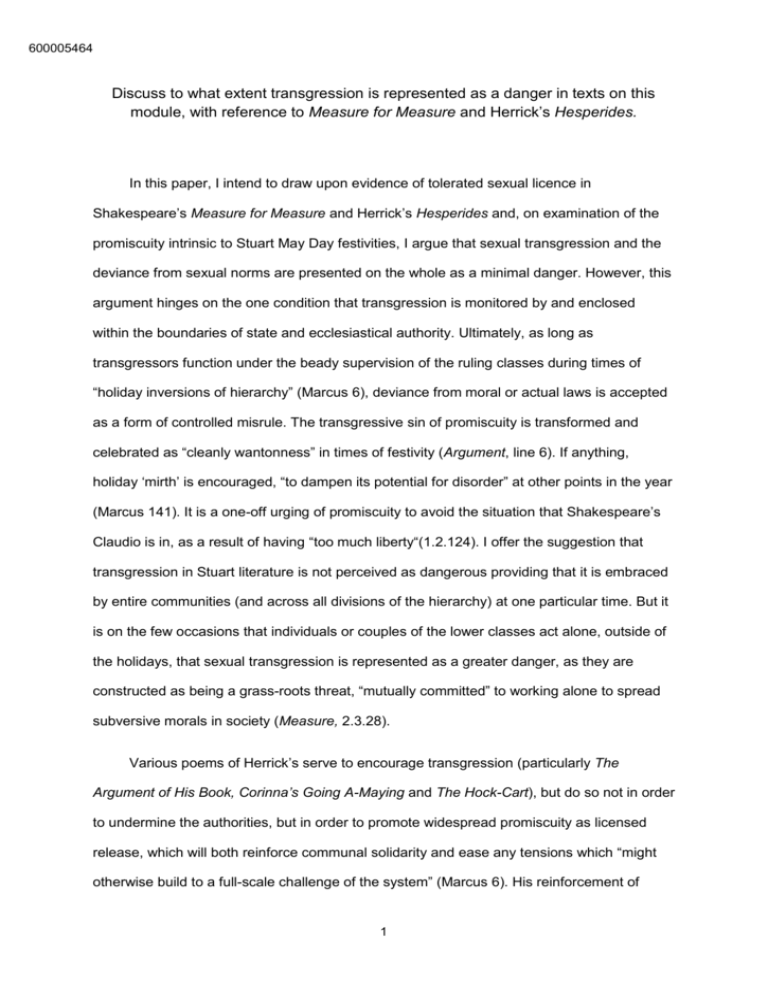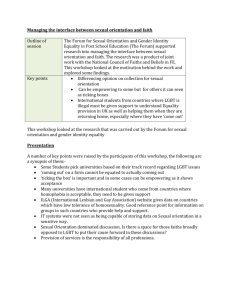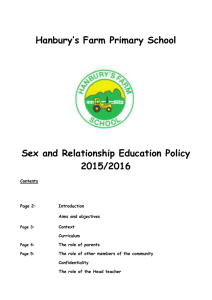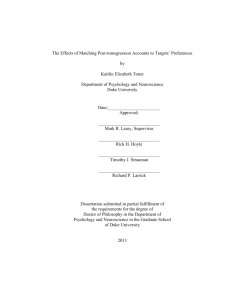
600005464
Discuss to what extent transgression is represented as a danger in texts on this
module, with reference to Measure for Measure and Herrick’s Hesperides.
In this paper, I intend to draw upon evidence of tolerated sexual licence in
Shakespeare’s Measure for Measure and Herrick’s Hesperides and, on examination of the
promiscuity intrinsic to Stuart May Day festivities, I argue that sexual transgression and the
deviance from sexual norms are presented on the whole as a minimal danger. However, this
argument hinges on the one condition that transgression is monitored by and enclosed
within the boundaries of state and ecclesiastical authority. Ultimately, as long as
transgressors function under the beady supervision of the ruling classes during times of
“holiday inversions of hierarchy” (Marcus 6), deviance from moral or actual laws is accepted
as a form of controlled misrule. The transgressive sin of promiscuity is transformed and
celebrated as “cleanly wantonness” in times of festivity (Argument, line 6). If anything,
holiday ‘mirth’ is encouraged, “to dampen its potential for disorder” at other points in the year
(Marcus 141). It is a one-off urging of promiscuity to avoid the situation that Shakespeare’s
Claudio is in, as a result of having “too much liberty“(1.2.124). I offer the suggestion that
transgression in Stuart literature is not perceived as dangerous providing that it is embraced
by entire communities (and across all divisions of the hierarchy) at one particular time. But it
is on the few occasions that individuals or couples of the lower classes act alone, outside of
the holidays, that sexual transgression is represented as a greater danger, as they are
constructed as being a grass-roots threat, “mutually committed” to working alone to spread
subversive morals in society (Measure, 2.3.28).
Various poems of Herrick’s serve to encourage transgression (particularly The
Argument of His Book, Corinna’s Going A-Maying and The Hock-Cart), but do so not in order
to undermine the authorities, but in order to promote widespread promiscuity as licensed
release, which will both reinforce communal solidarity and ease any tensions which “might
otherwise build to a full-scale challenge of the system” (Marcus 6). His reinforcement of
1
600005464
traditional festival customs such as “Maypoles, hock carts, wassails, wakes” (Argument, line
3) and the resulting sexual licentiousness may be out of keeping with idealist notions of
chastity, but I contend that by inverting and intensifying normative behaviour, transgression
(sexual or otherwise) over a few weeks per year is not a danger but a social adhesive which
unites every “budding boy or girl” and “a thousand virgins on this day” (Corinna, lines 14, 43)
in a “symbolic abstinence from work, play, study, or daily habits” (Falassi 296). Corinna’s
Going A-Maying is recognisably the poem in which this subversive behaviour is most
prevalent. Herrick delights in the disorder of transgressive sexual activity, but stresses that
ultimately the pre-marital “green gown” inducing ‘games’ in the woods are a form of
courtship, as many have “wooed, and plighted troth/And chose their priest” (lines 49-51), and
will result in the strengthening of society through the religious union of a couple. This is
theoretical at any rate, as we see numerous examples of women being “affianced to her
oath, and the nuptial [not] appointed” in Measure for Measure (3.1.125-6). I argue that
Herrick deals with the transgression of sexual license through means of inversion, to the
extent that he reverses the established roles of promiscuity and chastity and this becomes
socially acceptable, almost obligatory; it is “sin/Nay, profanation to keep in” (lines 11-12) and
to choose not to participate in the licentiousness of May Day.
Measure for Measure, on the other hand, represents sexual transgression as licensed
inversion having run away with itself. We see in the lines “in time the rod/Becomes more
mocked than feared” (1.3.26-7) that controlled misrule of the masses becomes simply
transgressive misrule if performed for too long. It consequently poses a threat because the
lower classes have abused this freedom to an excessive degree and must therefore be
curtailed: “every scope by the immoderate use turns to restraint” (1.2.126-7). The ruling
classes fear the “vulgarity of the powerless is used as a weapon against the pretence and
hypocrisy of the powerful” (Stamm 47) and crack down on sexual licentiousness. However,
building on Stamm’s argument concerning “hypocrisy”, I argue that unbridled, rampant
transgression is only ever seen as dangerous when performed in the lower classes.
Transgression is represented as being allowed within the ruling classes because they are
2
600005464
not subject to the oppressive surveillance of the Viennese state, they are that same
surveillance: “Claudio, whom here you have warrant to execute, is no greater forfeit to the
law than Angelo who hath sentenced him” (4.2.156-8). Angelo’s wooing of Isabella and
sleeping with Mariana is no better or worse than the crime of pre-marital intercourse of which
Claudio is guilty, and yet there are double standards when it comes to their parallel
transgressions. Therefore, “we are left confronting a situation in which Angelo’s position is
ironically similar to Claudio’s” (Scott 799) and where figures of authority are as guilty as
sexual transgression as those they rule, but the lower classes are “exploited to legitimate an
exercise in authoritarian repression” (Dollimore 84). Angelo declares that “my authority bears
so credent bulk/That no particular scandal once can touch” (4.4.24-5), which is suggestive of
a sort of diplomatic immunity with which the authorities justify their inconsistency in attitudes
towards sexual transgression: they are the ones who survey, and set the standards against
which people transgress. Isabella also begs the Duke that he “do not banish reason for
inequality” (5.1.66-7) which proves that this inconsistency is not limited to the character of
Angelo, but to the ruling classes as a whole. I contend that the sexual license that Herrick
allows the lower classes on May Day as an inversion of hierarchy, is precisely that, an
adoption of authority’s standards, since the sexual immorality of the ruling classes is not
perceived as a transgression because they have no one to transgress against.
Herrick’s transgressive inversion of the usual morals of daily life would appear, under
different circumstances, to be blasphemous, as well as sexually immoral, and the reader is
inclined to wonder how Herrick’s Hesperides does not represent a danger to the church, in
the way that Measure for Measure represents “low-life” transgression as a danger to society
as a whole. Herrick favours the paganist rituals that Puritans tried so hard to quash, and
urges Corinna not to spend long on her prayers, to have sex before marriage and to obey
the authority of “the proclamation made in May” rather than the bible (line 40). I agree with
Falassi’s reading of the “extreme” nature of festival literature. He writes that those who
participate in festivals “carry to extreme consequences behaviour regulated by measure and
3
600005464
common sense in daily life” (298), but I purport that by the end of Corinna’s Going A-Maying
at least, the “extreme” license of “locks picked” (line 56) and the speaker’s blasphemous
instruction to “be brief in praying” (line 27) are brought to a close and “made ‘honest’ by the
timely intervention of the church” (Marcus 154). Stallybrass’s article Wee Feast in Our
Defense outlines how May Day activities such as hock carts, wakes and feasts were often
organised by the church and were charged for being held on church ground, to the effect
that controlled misrule actually funded ecclesiastical rule. Therefore we see that not only
does occasional transgression unite the community in a “harmless release of subversive
energies” (Stallybrass 352) but does so in a way that is overseen and regulated entirely by
the church. May Day rituals and the promiscuity they entail in stanzas one to four of Corinna,
extreme as they are, are inseparable from the ritual of the church, and therefore cannot pose
a great danger because the church is a part of state authority. Outside of festive holidays,
different rules apply, as I will argue later in this paper. Herrick seems familiar with Charles I’s
reissue of The Declaration of Sports and makes a direct reference to it as “the proclamation
made for May”. He responds as such to “the general complaint of our people” who criticised
the priests for “persuading them that no honest mirth or creation is lawful or tolerable in our
religion, which cannot but breed a great discontentment in peoples’ hearts” (Declaration
n.p.). Likewise, William Pasquil’s “Pasquil’s Palinodia, and his progresse to the taverne” of
1619 commemorates the “harmelesse mirth and honest neighborhood" that locals celebrate
at May Day, and significantly points out that “no capritious Constables disturbe them/Nor
justice of the peace did seeke to curbe them/Nor peevish Puritan in rayling sort/Nor overwise Church-warden spoyl'd the sport” (n.p.). Contemporary texts quite obviously
demonstrate the dissatisfaction and potential for rebellion within the masses, so to not allow
transgression in times of “honest mirth and creation” and as “sport” would represent a
greater danger than that of the actual transgression itself (especially as this would be an
even greater hypocrisy on the part of the authorities). Gluckman writes that although “rites of
reversal obviously include a protest against the established order […] they are intended to
preserve and strengthen the established order” (109), thus Herrick demonstrates that the
4
600005464
“rites of reversal” permitted and overseen by the church will strengthen respect for (and
therefore “preserve”) the authority of the church. May Day transgression, I claim then, is
actually represented by Herrick as being of benefit to the authorities, and not of danger. The
idea of recurrent “rites” and ritual are propagated by Marcus who states that “the ritualised
promiscuity of the maygames is cleansed and assimilated into the order of the Church”
(102). Accordingly, I argue that if figures of state or ecclesiastical authority feared the
restrained passions and the danger they may pose, organised festivities should
hypothetically have calmed those fears because they had “the advantage of being public
and therefore open to surveillance and control” (Stallybrass 352). The promiscuity of May
Day, although not a form of transgression officially licensed by the authorities, is part and
parcel of the general licensed release and inversion that is permitted under the surveillance
of the church/state, and to prevent it would pose more of a threat than to temporarily allow it.
Leading on from this point, I contend that when authorities retain no surveillance and
remain unaware of sexual transgression, it is perceived as and manipulated into being a
greater danger, because Angelo (the sole figure of authority in much of Measure) twists
sexual laxity into an act of underground, continuous deviancy on the part of individuals,
rather than, as Herrick’s speaker portrays it, as an acknowledged and overseen act of
temporary inversion. However, pre-marital sex is acknowledged by Shakespeare’s other
characters as “there’s many have committed it” (2.2.89), but the un-surveyed and
“unregulated are by definition the ungoverned, and always thereby potentially subversive of
government” (Dollimore 80). I therefore argue that, although sexual transgression is
widespread, Measure for Measure works primarily to cherry-pick the licentious transgression
of particular individuals or couples to follow “the rigour of the statute/To make him an
example” (1.4.67-8) and represents it as more of a danger than it is in reality. Lucio is “a
fellow of much licence” (3.1.461); Angelo, the singular figure of authority, “hath a licence in’t”
(2.4.145) and Claudio and Julietta are depicted as being a couple working to subvert
authority, despite the fact that Claudio assures us that “she is fast my wife/ save that we do
5
600005464
the denunciation lack/of outward order” (1.2.144-8) and “pre-marital sexual intercourse with
a promised husband was a socially accepted practice” (Quaife 241). I am therefore aiming to
demonstrate that sexual transgression in Measure for Measure is as prevalent as it is in
Hesperides, but it is crucial to note that the ‘crimes’ of Shakespeare’s transgressors are
exaggerated as being deliberately deviant because they are not committed at a time
licensed and recognised by the state. Dollimore accurately summarises this concept in the
quotation “whatever subversive identity the sexual offenders in this play possess is a
construction put upon them by the authority that wants to control them” (72). During MayDay, the church and state oversees licensed transgression, but at all other times of the year
when “quite athwart/Goes all decorum” (1.3.30-1), they control its transgressors by branding
them dangerous sexual criminals, anarchists who “threaten to engulf the state unless
sexuality is subjected to renewed and severe regulation” (Dollimore 72). Eventually Pompey
enquires “does your worship mean to geld and splay all the youth of the city?” (2.1.219-20),
but he knows, of course, that this is impossible, so Angelo’s policy is to cherry-pick
individual transgressors of whom he is aware, as he cannot possibly survey the entire city at
once. It is clear that those who are, during May Day, harmless and surveyed transgressors
become criminals “demonised as a threat to law” (Dollimore 73) because the control and
surveillance imposed on May Day does not apply to the rest of the year.
Whereas I maintain that in Hesperides festivities are permitted as a preservation of
tradition and as a promotion of community solidarity, in Measure for Measure I argue that
individual instances of pre-marital sex are intentionally misrepresented as more dangerous
because “sexuality under the happy aegis of festival is preferable to more modern forms of
exploitation” (Marcus 153). I argue that transgression outside of holiday periods remains unsurveyed and therefore the exploitative “houses in the suburbs of Vienna must be plucked
down” (1.2.94) and individual transgressors must be made an example of by “strict statutes
and most biting laws” , as transgression is represented as only being a danger when it goes
unrecognised.
6
600005464
Works Cited
Dollimore, Jonathan. “Transgression and Surveillance in Measure for Measure.” Political
Shakespeare: New Essays in Cultural Materialism. Ed. Jonathan Dollimore, and Alan
Sinfield. Manchester: Manchester UP, 1985. 72-87. Print.
Falassi, Alessandro. "Festival." Folklore: an Encyclopedia of Beliefs, Customs, Tales, Music
and Art. Vol. 2. Ed. Thomas A. Green. Santa Barbara: ABC-Clio, 1997. Print.
Gluckman, Max. Custom and Conflict. Oxford: Blackwell, 1955. Print.
Herrick, Robert. Hesperides.
King James I. The Declaration of Sports. London: n.p., 1633. Web. 27 Feb. 2012.
Marcus, Leah S. "Churchman Among the Maypoles: Herrick and the Hesperides." The
Politics of Mirth. Chicago: Chicago UP, 1986. Print.
Pasquil, William. Pasquils palinodia, and his progresse to the taverne where after the survey
of the sellar, you are presented with a pleasant pinte of poeticall sherry. London:
Thomas Harper, 1634. EEBO. Web. 27 Feb. 2012.
Quaife, G R. "The Consenting Spinster in a Peasant Society: Aspects of Premarital Sex in
"Puritan" Somerset 1645-1660." The Journal of Social History 11.2 (1977): 228-44.
JSTOR. Web. 28 Feb. 2012.
Scott, Margaret. "Our City's Institutions: Some Further Reflections on the Marriage Contracts
on Measure for Measure." ELH 49.4 (1982): 790-804. JSTOR. Web. 27 Feb. 2012.
Shakespeare, William. Measure for Measure. Oxford: Oxford Paperbacks, 2008. Print.
Stallybrass, Peter. “Wee Feast in Our Defense: Patrician Carnival in Early Modern England.”
Renaissance Historicism: Selections from English Literary Renaissance. Ed. Arthur F.
Kinney, Dan S. Collins. Amherst: Massachusetts UP, 1987. 348-66. Print.
Works Consulted
Bristol, Michael D. Carnival and Theater: Plebiean Culture and the Strict Authority in
Renaissance England. London: Routledge, 1989. Print.
Stallybrass, Peter, and Alison White. The Politics and Poetics of Transgression. Cambridge:
CUP, 1986. Print.
7









